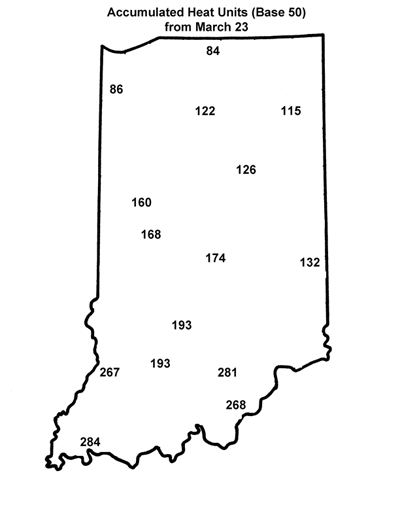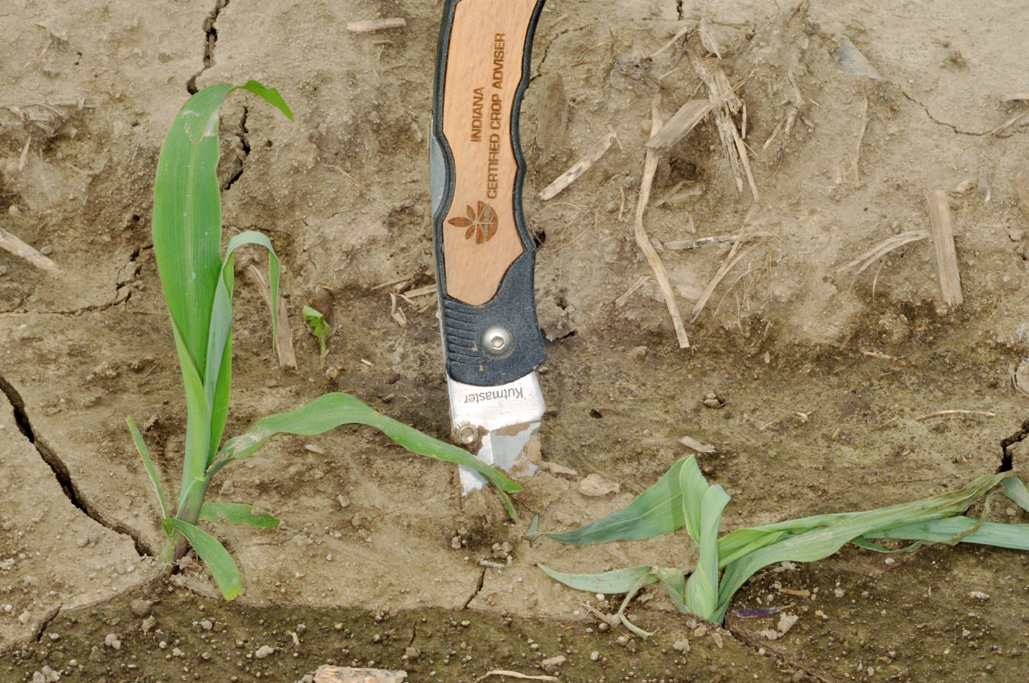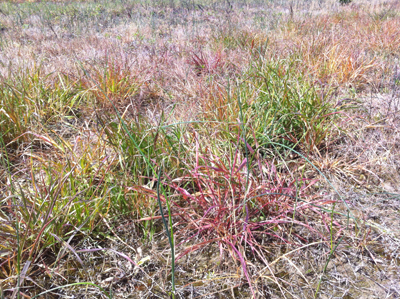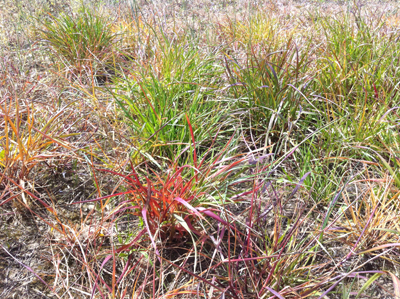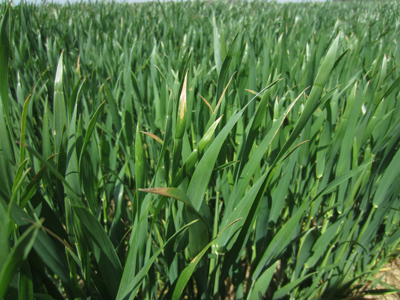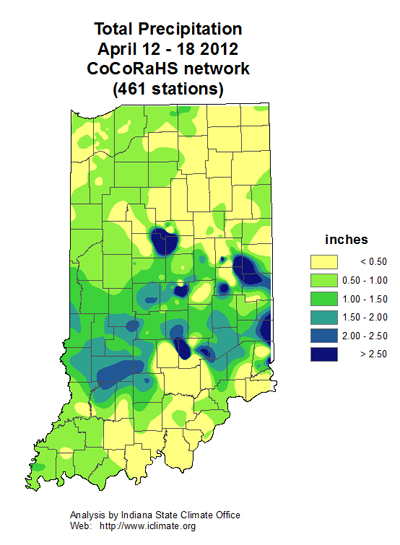Pest & Crop Newsletter, Entomology Extension, Purdue University
- Possibility for Black Cutworm Cutting in Southern Indiana...Already!
- Black Cutworm Adult Pheromone Trap Report
Possibility for Black Cutworm Cutting in Southern Indiana...Already! - (Christian Krupke and John Obermeyer)
- Black cutworm moths continue to arrive, adding to the record catches this year.
- Larval development is being tracked by accumulated heat units (base 50°F) from time of significant moth captures, already there in extreme southern counties. SCOUT NOW!
- Large (cutting) larvae are difficult to control successfully with insecticides, so get them early.
- Seed insecticides and Bt-corn will provide suppression of this pest, but will NOT control heavy populations.
As described in an earlier article, a round of storms that hit the southern states in the third week of March brought record numbers of black cutworm moths our way. Significant numbers of moths continue to be captured by our pheromone trap cooperators (see "Black Cutworm Adult Pheromone Trap Report")..
We track the development of the black cutworm from the time of an intensive capture (March 23 this year) to predict first cutting/damage (refer to accompanying map). Based on the growth development model, it takes approximately 300 heat units (above the 50°F base) from egg hatch to the stage when black cutworm larvae begin to cut plants. We are already approaching the required heat unit accumulation in southern Indiana counties. Scouting emerged corn in these areas NOW is strongly encouraged. Leaf injury, though less noticeable, will likely be present before cutting, as this is done by smaller larvae. Pheromone trapping of moths and tracking of heat unit accumulations for first cutting is not an exact science, but it does give us a good indication of what to expect and when to start looking. However, it is not possible to predict if individual fields will be infested.
With over a quarter of Indiana's corn planted (Indiana Ag Statistics, April 15 Weekly Report), moths may have found previously weedy/cover crop fields as an ideal egg-laying site. Tillage at, or just before, planting will provide little control of the eggs or newly hatched larvae. Producers may have a false sense of security with the seed-applied insecticides and/or Bt-corn. As many learned the hard way last year, these technologies don't stand-up to severe infestations, which certainly has possibilities this year. The next 2-3 weeks will tell the tale, so stay tuned. Happy Scouting!
Both of these plants have been cut below the ground, probably by the same black cutworm.
![]()
Click here for the Black Cutworm Adult Pheromone Trap Report
![]()
Annual Ryegrass: Hard to Control Cover Crop or Weed? – (Travis Legleiter and Bill Johnson)
An increasing push of cover crops and rapid adoption of cover crops such as annual ryegrass have been a great concern to weed scientist’s at Purdue. Our major concerns have been failure to control of annual ryegrass cover crops with burndown applications and the lack of education from cover crop promoters regarding the differences between annual ryegrass and rye.
One of the most popular cover crops to being promoted in Indiana is annual ryegrass (Lolium multiflorum). This grass species is also known as Italian ryegrass, which is a weedy species that is of economical impact in southern and western regions of the United States, including biotypes that are herbicide resistant. The escape of this species from a cover crop to a weed is likely if herbicide burndown programs are not successful in controlling annual ryegrass prior to production crop planting. This situation has occurred to our own program at a Purdue research facility in which previous escapes of annual ryegrass were not controlled with 0.75 lb ae glyphosate/acre applied at the end of March on 6-8” plants. Evaluations two weeks following the application deemed the control as a failure and further herbicide applications were made in an attempt to control the annual ryegrass. Current recommendations from Purdue University are to apply glyphosate at an increased rate (1.5 lb ae/A) to small annual ryegrass plants. In a spring like we have experienced this year, annual ryegrass has flourished in the warm temperatures and the likelihood of timely applications to small plants was rare and reduced burndown control probable. Producers who have already made termination treatments to their cover crop need to scout fields and confirm complete death of all cover crops and determine further control practices that need to occur.
Photo taken 21 days after treatment of 0.75 lb ae/A glyphosate
Another major issue encountered is the lack of knowledge about the difference in ryegrass and rye. Many have assumed that the terms are interchangeable about one species of cover crop. This is a false assumption. There are large differences between these species, especially in the ease of control with herbicides. Ryegrass refers to annual ryegrass or Italian ryegrass (Lolium multiflorum), where as rye refers to cereal rye (Secal cereal). These two are completely different species and actually belong to separate genuses. Rye is the cereal that has been traditionally grown as a small grains crop that can get up to 6 ft. in height and can be controlled fairly easily with herbicide applications or rolling/crimping operations. Annual ryegrass is a winter annual forage-like grass that is very aggressive and grows to heights of three feet and is very difficult to control with herbicides, especially if it gets some size on it. If you are considering cover crops for the future, be aware that rye and ryegrass are two different species with different management tactics.
Currently the amount of data for control of cover crops with burndown applications is very small. In an effort to increase the data available to producers, Purdue University weed scientist plan to further evaluate the control of cover crops and the impacts of weedy escapes on production crops in the near future.
Photo taken 21 days after treatment of 0.75 lb ae/A glyphosate
Freeze Injury in Wheat – (Shaun N. Casteel)
Winter and early spring temperatures have been favorable for wheat growth and development. Indiana wheat was reported to be jointing in 57% and heading in 9% of the fields as of April 15. This is compared to 22% jointing and 0% heading when compared to the five-year average.
Mother nature switched the thermostat with several days (and nights) that were cooler than we had grown accustom to this year. In fact, many areas of Indiana experienced freezing conditions over two nights last week (April 10 and 11). The combination of advanced wheat development and the freezing temperatures raised concerns about freeze injury. The greatest threat of yield damage to wheat is during heading and flowering (Table 1). Fortunately, very few fields were heading and about one-third of our wheat acres were jointing during last week’s frosty nights.
Visual symptoms usually take 7 to 10 days of active growth to appear. The fields that I have scouted over the past couple of days demonstrated “freezer burn” of the leaf tips (Pictures 1 and 2), which should not be a major threat to yields. I have only heard of one field that has demonstrated bending of the lower stems. Floret sterility may be a possibility in those fields that were in the boot to heading stage last week. Only time will tell if this damage has occurred. I suggest scouting the wheat fields over the coming weeks, but I anticipate that minimal damage has occurred.
| Table 1. Freeze Injury in Wheat | |||
|---|---|---|---|
Growth |
Approximate injurious temp (2 hours) |
Advisory | Yield Effect |
| Tillering (1-5) |
12°F | Leaf chlorosis; burning of leaf tips; silage odor; blue cast to fields | Slight to Moderate |
| Jointing (6-7) |
24°F | Death of growing point; leaf yellowing or burning; lesions, splitting, or bending of lower stem; odor | Moderate to Severe |
| Boot (10) |
28°F | Floret sterility; spike trapped in boot; damage to lower stem; leaf discoloration; odor | Moderate to Severe |
| Heading (10.1-.5) |
30°F | Floret sterility; white awns or white spikes; damage to lower stem; leaf discoloration | Severe |
| Flowering (10.51-.54) |
30°F | Floret sterility; white awns or white spikes; damage to lower stem; leaf discoloration | Severe |
| Milk (11.1) |
28°F | White awns or white spikes; damage to lower stems; leaf discoloration; shrunken, roughened, or discolored kernels | Moderate to Severe |
| Dough (11.2) |
28°F | Shriveled, discolored kernels; poor germination | Slight to Moderate |
Source: ID-125 Comprehensive Guide to Wheat Management in Kentucky. p. 17
Picture 1. Leaf tip burn due to freezing temperatures in wheat that was jointing.
Picture 2. Leaf tip burn due to freezing temperatures in wheat that was jointing.
![]()
Corrected Link: Protecting Honey Bees During Field Crop Planting – (Christian Krupke)
Due to some tech issues with last weeks video version, we have an updated link below. Please use this youtube link to view the webinar from April 9. The article from last week’s Pest&Crop appears below:
Field crops planting season is underway in the Midwest. Although our field crops don’t need pollination to form a crop, they are important for most fruits and vegetables we eat. There has been a great deal of media attention on pollinator decline in general, and the plight of honey bees in particular. Insecticides, specifically neonicotinoids, have received research attention in search of the cause of these die-offs.
That’s where field crops come in - most of the annual crop acreage planted in North America this year will use neonicotinoid treated seed, close to 200 million acres total and over 90 million in corn alone. Neonicotinoids are a family of insecticides that are extremely toxic to honey bees, and recent research has suggested that honey bees that forage near these types of plantings may be at risk. The risk may be greatest during the period while crops are being planted. Dr. Christian Krupke and Dr. Greg Hunt (Purdue Extension Entomology) presented an overview of the current research at Purdue and elsewhere and offered suggestions for both field crop growers and beekeepers that can minimize the chances of honey bee exposure to these chemicals in the field. The recorded version of the webinar is available at the link below:
![]()

